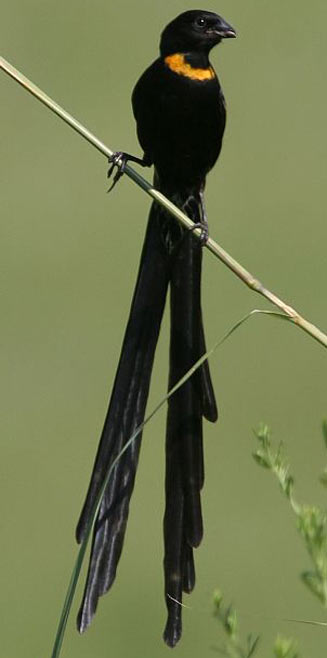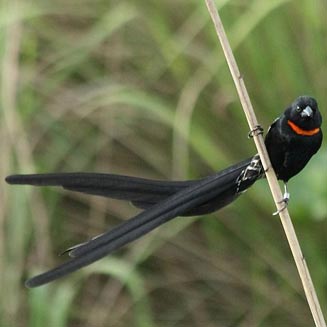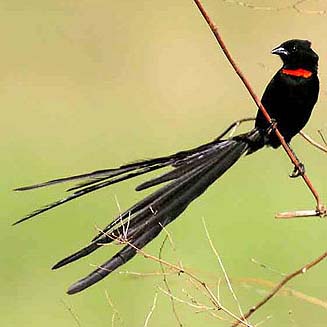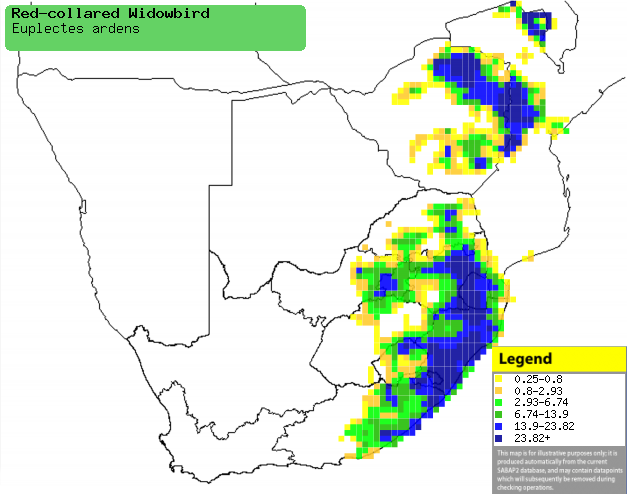|
Euplectes ardens
(Red-collared widowbird, Red-collared widow)
Rooikeelflap [Afrikaans];
Intakazana, Ujobela [Xhosa]; iNtaka (also applied to Fan-tailed
widowbird), uJojo [Zulu]; Molepe, Thaha, Tjobolo [South Sotho];
Muswewadepa [Shona]; Roodkeelwidavink [Dutch]; Euplecte veuve-noire
[French]; Schildwida [German]; Viúva-de-colar-vermelho [Portuguese]
Life
> Eukaryotes >
Opisthokonta
> Metazoa (animals) >
Bilateria >
Deuterostomia > Chordata >
Craniata > Vertebrata (vertebrates) > Gnathostomata (jawed
vertebrates) > Teleostomi (teleost fish) > Osteichthyes (bony fish) > Class:
Sarcopterygii (lobe-finned
fish) > Stegocephalia (terrestrial
vertebrates) > Tetrapoda
(four-legged vertebrates) > Reptiliomorpha > Amniota >
Reptilia (reptiles) >
Romeriida > Diapsida > Archosauromorpha > Archosauria >
Dinosauria
(dinosaurs) > Saurischia > Theropoda (bipedal predatory dinosaurs) >
Coelurosauria > Maniraptora > Aves
(birds) >
Order: Passeriformes > Family: Ploceidae
> Genus: Euplectes
 |
 |
 |
|
Red-collared widowbird (yellow-collared
morph), Harding, South Africa. [photo
Trevor Hardaker ©] |
Red-collared widowbird, Cedara Farm,
Pietermaritzburg, South Africa. [photo Alan Manson
©] |
For information about this species, see
www.birdforum.net/opus/Red-collared_Widowbird Distribution and habitat
Occurs in patches across sub-Saharan Africa, from Guinea to
Ethiopia south to southern Africa. Here it is locally common in the eastern half
of South Africa and Zimbabwe extending into Mozambique, favouring savanna, tall
grassland, scrub and cultivated land, generally more arid than other widowbird
and bishop species.
|
 |
|
Distribution of Red-collared widowbird in southern Africa,
based on statistical smoothing of the records from first SA Bird Atlas
Project (©
Animal Demography unit, University of
Cape Town; smoothing by Birgit Erni and Francesca Little). Colours range
from dark blue (most common) through to yellow (least common).
See here for the latest distribution
from the SABAP2. |
Predators and parasites
The Red-collared widowbird (in various forms) has been
recorded as prey of the following animals
- Eggs and newly-hatched nestlings
- Fledglings
Food
It mainly eats grass seeds, supplemented with berries,
nectar and insects, doing most of its foraging in large flocks on the ground or
in the foliage of plants. The following food items have been recorded
in its diet:
- Plants
- grass seeds
- Panicum maximum (Guinea grass)
- Sorghum (sorghum)
- nectar
- Leonotis (wild daggas)
- Aloe ferox (Bitter aloe)
- berries
- Insects
Breeding
- Polygynous solitary nester, as successful males may mate with up to about
2-3 females in a breeding season, defending their territory against most
other Euplectes species except
Long-tailed widowbird and Yellow bishop.
- The nest is built solely by the male, consisting of an oval-shaped
structure with a side entrance, woven using fine grass leaves and stems and
lined by the female with grass inflorescences and seed heads. It is
typically placed in a shrub, bush or tuft of grass, the leaves of which are
often incorporated into the nest roof.
- Egg-laying season is from October-April, peaking from November-February.
- It lays 2-6 eggs, which are incubated solely by the female for about
12-15 days.
- The chicks are fed by the female only, leaving the nest after about
14-17 days.
Threats
Not threatened.
References
-
Hockey PAR, Dean WRJ and Ryan PG 2005. Roberts
- Birds of southern Africa, VIIth ed. The Trustees of the John Voelcker
Bird Book Fund, Cape Town.
|
